中国著名建筑师贝聿铭全英文介绍Ieoh Ming Pei
- 格式:ppt
- 大小:1.89 MB
- 文档页数:15
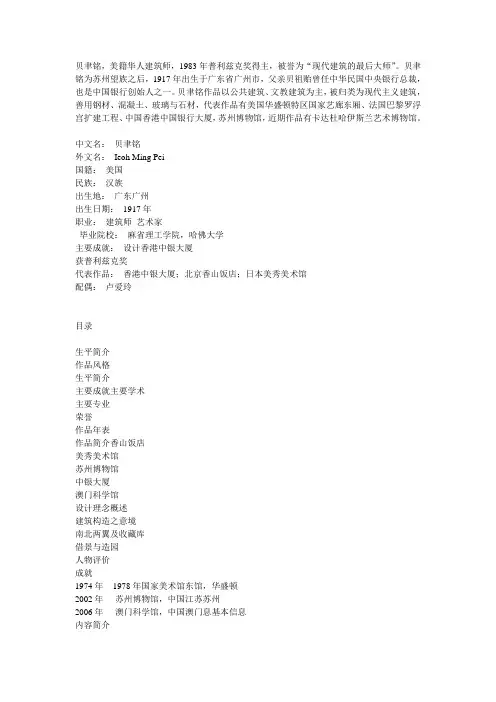

貝聿銘建築大師 貝聿銘貝聿貝聿ㄩˋ 銘貝聿銘(英文名: 貝聿銘(英文名:Ieoh MingPeiMingPei , ,1917 1917年 年4 4月 月2626日-),美籍華 人建築師,祖籍蘇州,生於廣州,其父是中國銀行創始人之一貝祖怡。
怡。
10 10歲隨父親來到上海, 歲隨父親來到上海,1818歲 到美國。
先後在麻省理工學院和哈佛大學學習建築。
於 佛大學學習建築。
於19551955年建立 建築事務所。
建築事務所。
19901990年退休。
作為最後一個現代主義建築「大師」,他被人描述成為一個注重於抽象形式的建築師抽象形式的建築師。
他喜好的材料 包括 包括石材 石材、 、混凝土 混凝土、 、玻璃 玻璃和 和鋼 鋼。
。
簡介簡介 貝聿銘 貝聿銘1917 1917年 年4 4月 月26 26日生於廣州。
日生於廣州。
19181918年其父親出任中國銀行香港分 行總經理,貝氏在香港度過他的童年,入讀聖保羅書院。
行總經理,貝氏在香港度過他的童年,入讀聖保羅書院。
1927 1927年父親調 職舉家搬至上海,住在有名的蘇州園林獅子林當中。
初中就讀上海青年 會中學,高中畢業自聖約翰大學附屬中學,後來赴賓州大學攻讀,因為 認為自己沒有畫圖的天賦而轉讀劍橋市的麻省理工學院,貝氏埋首於圖 書館,努力吸收歐洲近代建築相關的資訊, 書館,努力吸收歐洲近代建築相關的資訊,柯比意柯比意的作品是他最醉心的 , ,日後貝氏作品所呈現的雕塑性 ,就是深受柯比意的影響 ,就是深受柯比意的影響。
。
1939 1939年畢 業。
在 在貝氏早期的作品有密斯的影子 貝氏早期的作品有密斯的影子,不過,不過他不像密斯以坡璃為主要建 材,貝氏採用混凝土 材,貝氏採用混凝土,如 ,如紐約富蘭克林國家銀行 紐約富蘭克林國家銀行, ,鎮心廣場住宅區 鎮心廣場住宅區, ,夏 威夷東西文化中心。
威夷東西文化中心。
↑夏威夷東西文化中心→鎮心廣場住宅區 →鎮心廣場住宅區到了中期,歷練累積了多年的經驗,貝氏充分掌握了混凝土的性質,作品趨向於 了混凝土的性質,作品趨向於柯比意式的雕塑感柯比意式的雕塑感, 其中當以 其中當以全國大氣研究中心全國大氣研究中心,達拉斯市政廳,等皆 屬此方面的經典之作。

贝聿铭简介贝聿铭(“聿”,拼音:yù,注音:ㄩˋ,粤拼:leot9或wat9,英文名:Ieoh Ming Pei,署名:I. M. Pei,1917年4月26日-),美籍华人建筑师,1983年普利策克奖得主,被誉为“现代主义建筑的最后大师”(the last master of high modernist architecture)。
贝聿铭为苏州望族之后,出生于民初广东省广州市,父亲贝祖贻曾任中华民国中央银行总裁,也是中国银行创始人之一,生母姓庄,清廷国子监祭酒之后,于贝氏13岁时罹癌过世,继母蒋士云,为中华民国驻外使节之女。
贝氏有一个姐姐,两个弟弟、两个妹妹,妻子卢艾琳为中国留美学生,他们育有3子1女,其中贝建中(Chien Chung (Didi) Pei)与贝礼中(Li Chung (L.C.) Pei)皆是美国著名建筑师。
贝聿铭作品以公共建筑、文教建筑为主,被归类为现代主义建筑,善用钢材、混凝土、玻璃与石材,代表作品有美国华盛顿特区国家艺廊东厢、法国巴黎卢浮宫扩建工程、中国香港中国银行大厦、1970年日本世界博览会中华民国馆,近期作品有卡塔尔多哈伊斯兰艺术博物馆。
生平早年生活民初时期,贝聿铭父亲参与筹组中国银行,1915年调任中国银行广东分行,贝氏父便带着妻女离开故乡苏州,迁往广州市,两年后(1917年)4月26日,贝聿铭于广州市出生。
1918年贝氏父亲为逃避政争,举家移居香港,设立中国银行香港分行,出任总经理,贝氏的弟妹皆在香港出生,贝氏在香港度过他的童年,入读圣保罗书院。
1927年贝氏父亲获政府谅解,出任中国银行上海分行经理,一家人就搬到上海。
贝聿铭初中就读上海青年会中学,高中毕业自圣约翰大学附属中学,因其祖父贝理泰要求,贝氏每年暑假会回苏州,入住祖宅狮子林,苏州园林的生活经验,影响到贝氏日后的设计哲学:“人与自然共存”、“家庭的真正含义:内聚力和历史”[3]。
贝聿铭父亲公务繁忙,贝氏与姊弟妹主要由母亲负责照顾教养,其母亲是虔诚的佛教徒,待人热情,交友广阔,贝氏深受其母影响。

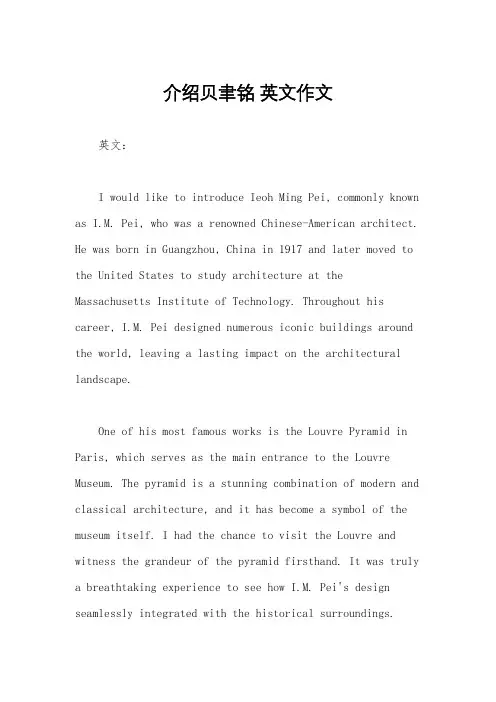
介绍贝聿铭英文作文英文:I would like to introduce Ieoh Ming Pei, commonly known as I.M. Pei, who was a renowned Chinese-American architect. He was born in Guangzhou, China in 1917 and later moved to the United States to study architecture at the Massachusetts Institute of Technology. Throughout his career, I.M. Pei designed numerous iconic buildings around the world, leaving a lasting impact on the architectural landscape.One of his most famous works is the Louvre Pyramid in Paris, which serves as the main entrance to the Louvre Museum. The pyramid is a stunning combination of modern and classical architecture, and it has become a symbol of the museum itself. I had the chance to visit the Louvre and witness the grandeur of the pyramid firsthand. It was truly a breathtaking experience to see how I.M. Pei's design seamlessly integrated with the historical surroundings.Another remarkable project of I.M. Pei is the Bank of China Tower in Hong Kong. This skyscraper is a masterpiece of structural engineering and architectural innovation. Its sharp angles and sleek design make it a standout in the Hong Kong skyline. I remember standing at the base of the tower, looking up and feeling a sense of awe at the sheer magnitude of the building.In addition to his architectural achievements, I.M. Pei was also known for his ability to blend Eastern and Western influences in his designs. This cultural fusion is evident in the Suzhou Museum in China, where traditional Chinese elements are combined with modern architectural principles.I had the opportunity to explore the museum and was impressed by how I.M. Pei seamlessly integrated the old and the new, creating a space that pays homage to the rich history of Suzhou.Overall, I.M. Pei's impact on the world of architecture is undeniable. His ability to create timeless and iconic structures has left a lasting legacy for future generationsto admire and appreciate.中文:我想介绍一下贝聿铭,他是一位著名的华裔美国建筑师。
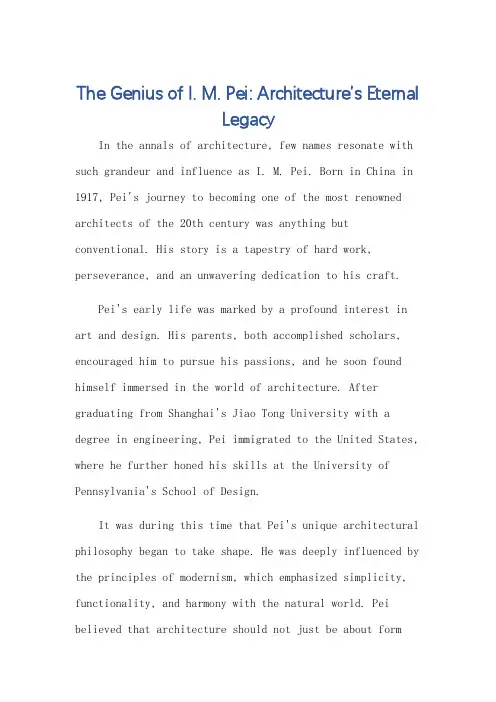
The Genius of I. M. Pei: Architecture's EternalLegacyIn the annals of architecture, few names resonate with such grandeur and influence as I. M. Pei. Born in China in 1917, Pei's journey to becoming one of the most renowned architects of the 20th century was anything but conventional. His story is a tapestry of hard work, perseverance, and an unwavering dedication to his craft.Pei's early life was marked by a profound interest in art and design. His parents, both accomplished scholars, encouraged him to pursue his passions, and he soon found himself immersed in the world of architecture. After graduating from Shanghai's Jiao Tong University with a degree in engineering, Pei immigrated to the United States, where he further honed his skills at the University of Pennsylvania's School of Design.It was during this time that Pei's unique architectural philosophy began to take shape. He was deeply influenced by the principles of modernism, which emphasized simplicity, functionality, and harmony with the natural world. Pei believed that architecture should not just be about formand function, but also about creating spaces that were both beautiful and meaningful.Pei's career was marked by a series of groundbreaking projects that showcased his exceptional talent and vision. One of his earliest and most famous works is the Louvre Pyramid in Paris. Commissioned by the French government in 1983, the project was a controversial one, as Pei's design departed significantly from the Louvre's classical facade. However, the Pyramid's successful integration into the Parisian landscape and its ability to draw in millions of visitors every year have since vindicated Pei's vision.Another notable project is the John F. Kennedy Libraryin Boston. Completed in 1979, the library's design is a testament to Pei's mastery of both form and function. The building's bold geometry and use of reflective glass notonly complement its surrounding landscape but also create a serene and contemplative space that honors Kennedy's legacy. Pei's legacy is not just about his individual projects, however. His influence extends to the next generation of architects and designers, who have been inspired by his dedication to his craft and his belief in thetransformative power of architecture. His work has also been recognized with numerous awards and accolades, including the Pritzker Architecture Prize, which is considered the Nobel Prize of architecture.In conclusion, I. M. Pei's life and work are a testament to the power of vision, perseverance, and dedication. His legacy will forever be etched in the annals of architecture, serving as a beacon of inspiration for generations of designers and architects who come after him. His belief in the transformative power of architecture and his commitment to creating spaces that are both beautiful and meaningful have left an indelible mark on the world, and his influence will undoubtedly continue to resonate for centuries to come.**贝聿铭:建筑界的永恒传奇**在建筑史上,鲜有人的名字能如贝聿铭(I. M. Pei)般散发出如此宏伟与深远的影响。
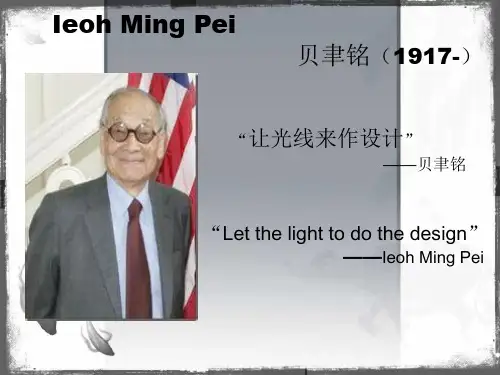
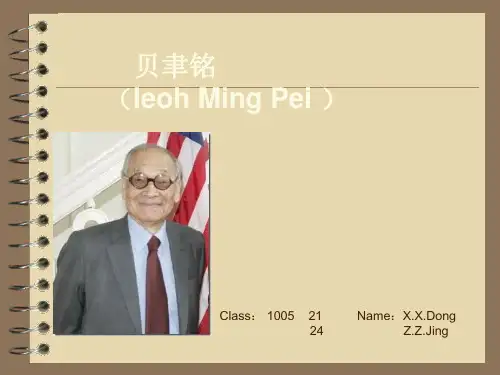
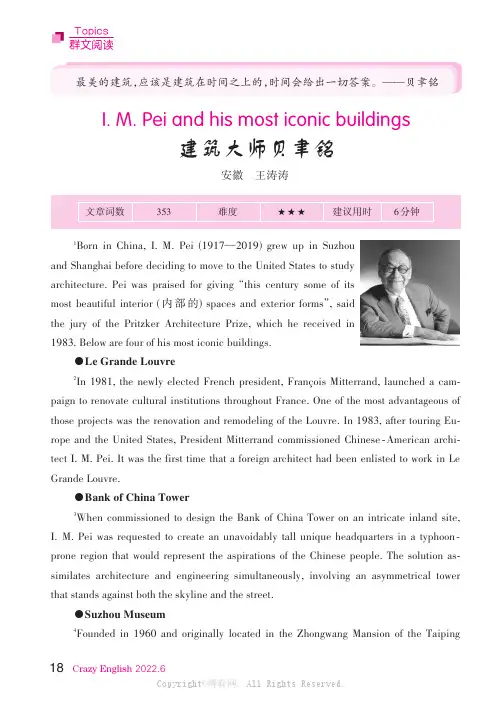
最美的建筑,应该是建筑在时间之上的,时间会给出一切答案。
——贝聿铭I.M.Pei and his most iconic buildings建筑大师贝聿铭安徽王涛涛1Born in China,I.M.Pei (1917—2019)grew up in Suzhouand Shanghai before deciding to move to the United States to studyarchitecture.Pei was praised for giving “this century some of itsmost beautiful interior (内部的)spaces and exterior forms ”,said the jury of the Pritzker Architecture Prize,which he received in 1983.Below are four of his most iconic buildings.●Le Grande Louvre2In 1981,the newly elected French president,François Mitterrand,launched a cam⁃paign to renovate cultural institutions throughout France.One of the most advantageous ofthose projects was the renovation and remodeling of the Louvre.In 1983,after touring Eu⁃rope and the United States,President Mitterrand commissioned Chinese ⁃American archi⁃tect I.M.Pei.It was the first time that a foreign architect had been enlisted to work in Le Grande Louvre.●Bank of China Tower3When commissioned to design the Bank of China Tower on an intricate inland site,I.M.Pei was requested to create an unavoidably tall unique headquarters in a typhoon ⁃prone region that would represent the aspirations of the Chinese people.The solution as⁃similates architecture and engineering simultaneously,involving an asymmetrical tower that stands against both the skyline and the street.●Suzhou Museum4Founded in 1960and originally located in the Zhongwang Mansion of theTaipingHeavenly Kingdom(太平天国),Suzhou Museum has been a highly⁃regarded museum with a number of significant Chinese cultural relics.The new Suzhou Museum designed by I.M. Pei was completed in October2006.Not only does the museum become a monumental (意义深远的)design building in Suzhou,but also a significant construction,merging the traditional southern Chinese architecture style and modern aesthetics.●JFK Presidential Library5In1963,then President John F.Kennedy viewed possible sites for a presidential li⁃brary and museum to be built in his name.After several years,the John F.Kennedy Presi⁃dential Library was finally finished and dedicated on October20,1979.Architect I.M.Pei s signature geometric shapes of concrete steel and glass created an appropriate stately monu⁃mentality.A juxtaposition(并置)of spaces and light quality along with a defined and clear circulation(循环)creates a logical story⁃line of its namesake.ReadingCheckⅠ.Choose the best answers according to the textDetail 1.What can we learn about I.M.Pei from the text?A.He was born in Suzhou on May26,1917.B.He studied architecture both at home and abroad.C.He won the Pritzker Architecture Prize for Le Grande Louvre.D.He preferred concrete steel and glass in his design. Detail 2.Which building requires to show the willingness of the Chinese people?A.Le Grande Louvre.B.Bank of China Tower.C.Suzhou Museum.D.JFK Presidential Library. Detail 3.Which building best suits people who enjoy both traditional and mod⁃ern Chinese aesthetics?A.Le Grande Louvre.B.Bank of China Tower.C.Suzhou Museum.D.JFK Presidential Library. Inference 4.In which column is this text likely to appear?A.Adventures.B.Celebrities.C.Current affairs.D.Historic events.Ⅱ.DiscussionDo you agree with the author s attitude towards cultural confidence?And how to estab⁃lish your own cultural confidence?LanguageStudyComplete the following phrases according to the text 1.充满be of2.工业区park3.拆毁down 4.阐明light on 5.文化自信cultural 6.世界各地allthe worldⅡ.DiscussionWhat other great famous Chinese architects and their designs do you know?Pleasesearch for more information about them and share it with your classmates.Language StudyⅠ.Discover the useful structure in the textnot only...but (also)...意为“不仅……而且……”,用来连接两个表示并列关系的成分,also 可以省略。

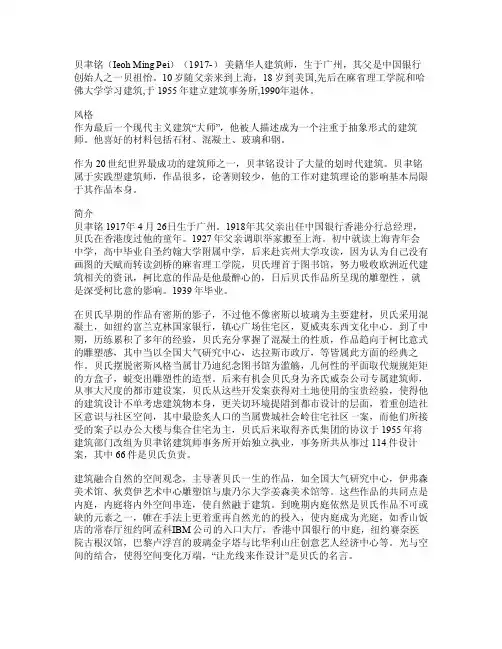
贝聿铭(Ie oh Mi ng Pe i)(1917-)美籍华人建筑师,生于广州,其父是中国银行创始人之一贝祖怡。
10岁随父亲来到上海,18岁到美国,先后在麻省理工学院和哈佛大学学习建筑,于1955年建立建筑事务所,1990年退休。
风格作为最后一个现代主义建筑“大师”,他被人描述成为一个注重于抽象形式的建筑师。
他喜好的材料包括石材、混凝土、玻璃和钢。
作为20世纪世界最成功的建筑师之一,贝聿铭设计了大量的划时代建筑。
贝聿铭属于实践型建筑师,作品很多,论著则较少,他的工作对建筑理论的影响基本局限于其作品本身。
简介贝聿铭1917年4月26日生于广州。
1918年其父亲出任中国银行香港分行总经理,贝氏在香港度过他的童年。
1927年父亲调职举家搬至上海。
初中就读上海青年会中学,高中毕业自圣约翰大学附属中学,后来赴宾州大学攻读,因为认为自己没有画图的天赋而转读剑桥的麻省理工学院,贝氏埋首于图书馆,努力吸收欧洲近代建筑相关的资讯,柯比意的作品是他最醉心的,日后贝氏作品所呈现的雕塑性,就是深受柯比意的影响。
1939年毕业。
在贝氏早期的作品有密斯的影子,不过他不像密斯以坡璃为主要建材,贝氏采用混凝土,如纽约富兰克林国家银行,镇心广场住宅区,夏威夷东西文化中心。
到了中期,历练累积了多年的经验,贝氏充分掌握了混凝土的性质,作品趋向于柯比意式的雕塑感,其中当以全国大气研究中心,达拉斯市政厅,等皆属此方面的经典之作。
贝氏摆脱密斯风格当属甘乃迪纪念图书馆为滥觞,几何性的平面取代规规矩矩的方盒子,蜕变出雕塑性的造型。
后来有机会贝氏身为齐氏威奈公司专属建筑师,从事大尺度的都市建设案,贝氏从这些开发案获得对土地使用的宝贵经验,使得他的建筑设计不单考虑建筑物本身,更关切环境提陹到都市设计的层面,着重创造社区意识与社区空间,其中最脍炙人口的当属费城社会岭住宅社区一案,而他们所接受的案子以办公大楼与集合住宅为主,贝氏后来取得齐氏集团的协议于1955年将建筑部门改组为贝聿铭建筑师事务所开始独立执业,事务所共从事过114件设计案,其中66件是贝氏负责。
介绍贝聿铭英文作文Beijing-born architect Ieoh Ming Pei, better known asI.M. Pei, is an iconic figure in the world of architecture. With his innovative designs and ability to blend modernity with tradition, Pei has left an indelible mark on the architectural landscape.Pei's architectural style is characterized by clean lines, geometric shapes, and the use of glass and steel.His designs often incorporate elements of both Eastern and Western architecture, creating a unique fusion of cultures. One of his most famous works is the Louvre Pyramid in Paris, which symbolizes the harmonious coexistence of the modern and the ancient.In addition to his innovative designs, Pei is also known for his ability to transform spaces and create environments that inspire and uplift. His buildings are not just functional structures, but works of art that evoke emotion and provoke thought. The Bank of China Tower inHong Kong, with its distinctive triangular shape, is a prime example of Pei's ability to create a sense of awe and wonder.Pei's impact on the architectural world extends beyond his individual designs. He has also been a mentor and inspiration to many young architects, encouraging them to push boundaries and think outside the box. His commitment to excellence and his unwavering belief in the power of architecture to shape society have made him a reveredfigure in the field.Despite his numerous accolades and achievements, Pei remains humble and down-to-earth. He has always been focused on his work and has never sought fame or recognition. Instead, his passion lies in creating spaces that enrich the lives of those who inhabit them.In conclusion, I.M. Pei is a visionary architect who has made a lasting impact on the world of architecture. His innovative designs, ability to blend cultures, and commitment to excellence have earned him a place among thegreatest architects of our time. Whether it is the Louvre Pyramid or the Bank of China Tower, Pei's buildings are not just structures, but works of art that inspire and uplift.。
贝聿铭的金字塔:现代建筑与传统元素的完美融合In the vast landscape of architecture, Ieoh Ming Pei's Pyramid stands as a beacon of modernity and tradition merged into a singular masterpiece. The pyramid, a symbol of ancient Egyptian civilization, is transformed by Pei's ingenious hands into a contemporary icon, embodying the essence of both the past and the future.Born in China and educated in the West, Pei's architectural philosophy is a harmonious blend of Eastern and Western aesthetics. His pyramid, a striking feature of the Louvre Museum in Paris, is a testament to this philosophy. The structure, while seemingly simple, is actually a complex interplay of lines, angles, and spaces that create a dynamic and arresting visual experience.The pyramid's exterior is composed of glass and steel, materials that are both modern and durable. The transparent glass allows natural light to flood the interior, creating a warm and inviting atmosphere. The steel framework, on the other hand, provides the necessary structural support while also adding a touch of industrial elegance.Inside, the pyramid houses the museum's main entrance and elevators, connecting the underground lobby with the upper floors. The design is both functional and aesthetic, with every detail carefully considered to enhance the visitor's experience. The pyramid's interior is as impressive as its exterior, with sleek lines and open spaces that encourage exploration and discovery.Pei's pyramid is not just a building; it is a work of art that challenges the conventions of architecture. It stands as a reminder of the power of creativity and innovation, even in the face of historical and cultural constraints. The pyramid's ability to blend the ancient with the modern, the traditional with the contemporary, is a testament to Pei's exceptional talent and vision.Moreover, the pyramid serves as a bridge between the Louvre's rich historical collections and the modern world. It welcomes visitors from all over the world, inviting them to embark on a journey through time and culture. In this way, Pei's pyramid not only enhances the Louvre's identity but also contributes to its global significance.In conclusion, Ieoh Ming Pei's pyramid is a masterpiece of modern architecture that successfully incorporates traditional elements. It is a symbol of Pei's unique vision and his ability to create structures that are both visually stunning and functionally efficient. The pyramid stands asa testament to the power of architecture to connect thepast with the future, the traditional with the modern, andto inspire us all to see the world in a new and exciting way.**贝聿铭的金字塔:现代建筑与传统元素的完美融合** 在建筑学的广阔天地中,贝聿铭的金字塔作为现代与传统完美融合的杰出作品,熠熠生辉。
有关贝聿铭的英语作文Title: The Legacy of I.M. Pei: Architectural Visionary and Cultural Icon。
Ieoh Ming Pei, known to the world as I.M. Pei, stands as one of the most influential architects of the 20th century. His architectural marvels, characterized by their bold geometric shapes, innovative use of materials, and integration with their surroundings, have left an indelible mark on skylines and landscapes around the globe. From the iconic Louvre Pyramid in Paris to the breathtaking Bank of China Tower in Hong Kong, Pei's designs continue to inspire awe and admiration. In this essay, we delve into the life, works, and enduring legacy of this architectural luminary.Born in Guangzhou, China, in 1917, I.M. Pei's early years were marked by both cultural richness andgeopolitical upheaval. He immigrated to the United Statesin 1935 to pursue his passion for architecture, eventually earning degrees from the Massachusetts Institute ofTechnology and Harvard University. Pei's formative years were greatly influenced by his exposure to the Bauhaus movement and the teachings of renowned architects such as Walter Gropius and Marcel Breuer.Pei's design philosophy was rooted in the belief that architecture should not only serve functional purposes but also evoke emotions and elevate the human experience. His mastery of light, space, and form enabled him to create buildings that transcended mere structures, becoming works of art that resonated with people on a profound level.One of Pei's most iconic creations is the Louvre Pyramid, commissioned in the 1980s to serve as the main entrance to the Louvre Museum in Paris. Despite initial controversy and criticism, the pyramid has since become a beloved symbol of the museum and a testament to Pei's visionary genius. Its sleek, modern design provides a striking contrast to the historic architecture of the Louvre while seamlessly blending with its surroundings.In addition to the Louvre Pyramid, Pei's portfolioboasts an impressive array of architectural marvels spanning the globe. The Bank of China Tower in Hong Kong, with its distinctive triangular shape and cutting-edge structural design, is a testament to Pei's ability to marry aesthetics with functionality. Similarly, the East Building of the National Gallery of Art in Washington, D.C., showcases Pei's skillful use of space and light to create a dynamic and immersive art experience.Beyond his architectural achievements, I.M. Pei was known for his humility, integrity, and unwavering dedication to his craft. He approached each project with meticulous attention to detail and a deep respect for the cultural and historical context in which it existed. His collaborative approach, combined with his keen artistic vision, earned him the admiration and respect of clients, colleagues, and admirers alike.Pei's influence extends far beyond the realm of architecture, shaping the way we perceive and interact with the built environment. His designs have become timeless landmarks, serving as a bridge between past and present,tradition and innovation. As we continue to marvel at the beauty and ingenuity of Pei's creations, we are reminded of the enduring power of architecture to inspire, uplift, and unite us as a global community.In conclusion, I.M. Pei's legacy as an architectural visionary and cultural icon is firmly cemented in the annals of history. His groundbreaking designs, characterized by their elegance, innovation, and timeless appeal, continue to captivate and inspire generations of architects, artists, and admirers worldwide. As we celebrate his life and work, we are reminded of the profound impact that one individual can have on the world through creativity, passion, and a relentless pursuit of excellence.。